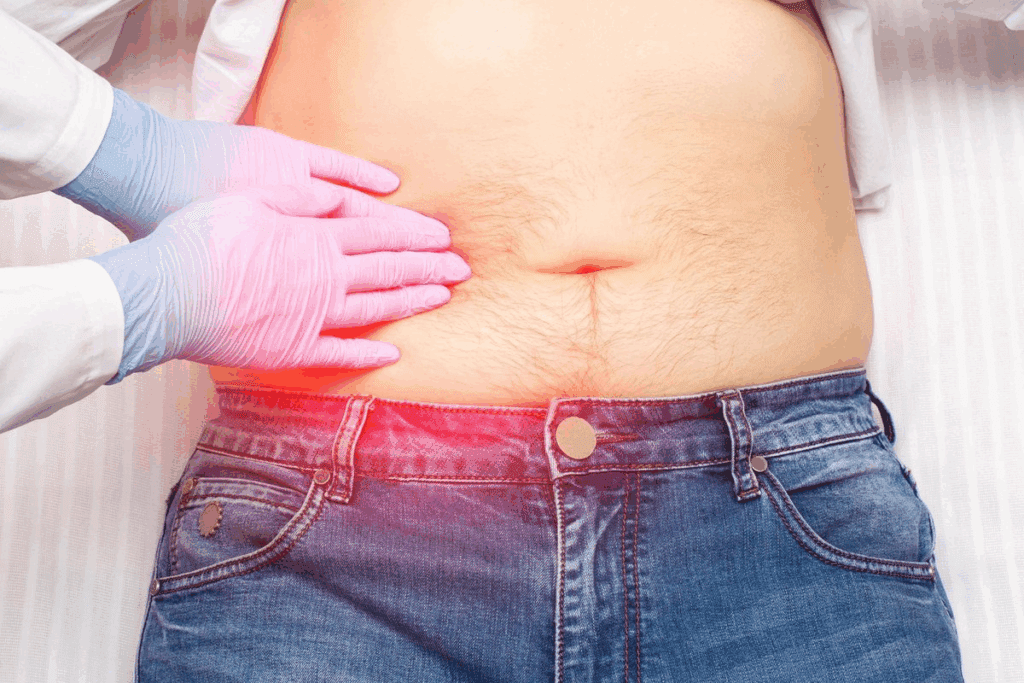Last Updated on November 26, 2025 by Bilal Hasdemir

Gallbladder infection, or cholecystitis, is a serious condition. It happens when the gallbladder gets inflamed. This usually occurs when gallstones block the cystic duct.A gallbladder infection is dangerous. Learn 7 alarming causes, symptoms, and how it leads to deadly complications or scarring.
This blockage causes bile to build up. This leads to inflammation and Daraz Seller Center severe complications if not treated.
It’s important to understand the causes and complications of cholecystitis. At Liv Hospital, we focus on patient care and follow international standards. This is key in treating such conditions.

The gallbladder is a key part of our digestive system. It stores and releases bile, a digestive fluid made by the liver. Bile helps break down fats and absorb them.
The gallbladder is a small, pear-shaped organ under the liver. It has three parts: the fundus, body, and neck. The gallbladder anatomy helps store and release bile.
The fundus is the rounded base, the body stores bile, and the neck connects to the cystic duct. This duct leads to the common bile duct.
The gallbladder wall has layers like the mucosa, muscularis, and serosa. The mucosa absorbs water and electrolytes, making bile more concentrated. The muscularis layer has smooth muscle that helps release bile.
The gallbladder’s main job is to store bile from the liver. When food reaches the small intestine, the gallbladder releases bile. This bile helps break down fats into smaller pieces for digestion.
The gallbladder also concentrates bile by removing excess water and electrolytes. This makes bile more effective at digesting fats and vitamins. The gallbladder function is key for fat digestion and absorption.
Knowing how the gallbladder’s role in digestion and its anatomy works is important. It helps us understand how problems with the gallbladder can cause digestive issues and other health problems.

Infection of the gallbladder is called cholecystitis. It can be acute or chronic. This happens when the gallbladder gets inflamed, often because of gallstones blocking the cystic duct. If not treated quickly, it can cause serious problems.
Acute cholecystitis is a sudden and severe inflammation of the gallbladder. It’s usually caused by gallstones blocking the cystic duct. This blockage leads to a buildup of bile, causing inflammation and severe infection. Symptoms include sharp pain in the upper right abdomen, fever, and nausea.
Chronic cholecystitis is a recurring or persistent inflammation of the gallbladder. It often comes from repeated episodes of acute cholecystitis or continuous irritation. This condition can cause scarring and thickening of the gallbladder wall, making it less functional.
Gallbladder infection is a big health problem. Its prevalence changes among different groups. Risk factors include gallstones, age, gender (with females being more at risk), and certain ethnic backgrounds.
| Risk Factor | Description | Impact Level |
| Gallstones | Presence of stones in the gallbladder | High |
| Age | Increased risk with advancing age | Moderate |
| Gender | Higher risk in females | Moderate |
| Ethnicity | Varied risk among different ethnic groups | Low to Moderate |
Knowing about these risk factors and types of gallbladder infection is key. It helps in early diagnosis and effective treatment. This can prevent complications and improve patient outcomes.
Gallbladder infections often happen when the cystic duct gets blocked. This blockage is usually caused by gallstones or acalculous cholecystitis. Knowing these causes helps doctors diagnose and treat gallbladder infections better.
Gallstones are hard deposits in the gallbladder. When they block the cystic duct, they stop bile from leaving the gallbladder. This leads to inflammation and infection.
The blockage makes the gallbladder swell and get inflamed, causing cholecystitis. Gallstones are the main reason for gallbladder infections.
Gallstones form due to several factors, including:
Acalculous cholecystitis happens without gallstones. It often affects very sick patients or those with severe infections. The exact reason is not known, but it might involve:
Acalculous cholecystitis is very serious and can be deadly if not treated quickly. Doctors need to be very careful, mainly in very sick patients.
Knowing the signs of gallbladder irritation is key to stopping it from getting worse. The gallbladder is vital for digestion. Any trouble here can harm your health.
Gallbladder irritation starts with small symptoms. These can get worse if ignored. Early signs include:
These signs can be easy to miss. They might seem like other stomach problems. So, it’s important to watch for any changes in your body.
If irritation isn’t treated, it can turn into inflammation, or cholecystitis. This is more painful and can cause serious problems like infection or gangrene of the gallbladder.
Many things can make irritation turn into inflammation. For example, gallstones blocking the cystic duct or acalculous cholecystitis, where there are no stones but inflammation happens.
Telling gallbladder irritation apart from other stomach problems can be hard. Symptoms can be similar. But, there are clues that can help figure out if it’s gallbladder-related.
| Symptom | Gallbladder Irritation | Other Digestive Issues |
| Pain Location | Upper right abdomen | Varies (e.g., lower abdomen for appendicitis) |
| Nausea and Vomiting | Often after fatty meals | Can occur at any time, not necessarily related to meals |
| Bloating and Gas | Intermittent | Common, can be persistent |
Knowing these differences is key for the right diagnosis and treatment. If symptoms don’t go away or get worse, it’s best to see a doctor. This can help avoid serious problems.
Knowing the symptoms of gallbladder infection is key for quick diagnosis and treatment. This infection, or cholecystitis, shows through various symptoms that need fast medical check-up.
The main symptom is sharp pain in the upper right abdomen. This pain can be very intense and spread to other spots. It feels like a sharp, stabbing pain that gets worse with movement or deep breathing.
Sometimes, the pain from gallbladder infection goes to the shoulder and back. This happens because the nerves in these areas are connected. The pain can be tricky to diagnose without a thorough check-up.
Other symptoms include fever, nausea, and vomiting. Fever shows there’s an infection. Nausea and vomiting can cause dehydration and imbalance of electrolytes if not treated right.
| Symptom | Description |
| Sharp Pain | Intense pain in the upper right abdomen |
| Referred Pain | Pain radiating to the shoulder and back |
| Fever | Elevated body temperature indicating infection |
| Nausea and Vomiting | Feeling queasy and vomiting, potentially leading to dehydration |
Seek emergency care if symptoms get worse or show signs of severe infection. Look out for high fever, severe abdominal tenderness, or persistent vomiting. Quick medical help can stop serious problems like gangrene or perforation of the gallbladder.
Diagnosing gallbladder infection involves several steps. These include a physical check-up, lab tests, and imaging studies. Getting the diagnosis right is key to treating the infection properly and avoiding serious problems.
A detailed physical exam is the first step in diagnosing gallbladder infection. Doctors look for signs of pain in the upper right part of the abdomen. They also check for muscle stiffness or a hard spot in the same area.
Key physical examination findings include:
Laboratory tests are vital in diagnosing gallbladder infection. They help find signs of inflammation and infection. Common tests include:
Laboratory findings can help differentiate between various causes of abdominal pain and support the diagnosis of gallbladder infection.
Imaging studies are key to confirming gallbladder infection and its severity. The most used imaging methods include:
By combining these diagnostic methods, doctors can accurately diagnose gallbladder infection. This helps them plan the best treatment.
The treatment for an infected gallbladder varies based on the infection’s severity and the patient’s health. It may include both medical and surgical methods.
For mild to moderate infections, antibiotics are often the first choice. These drugs fight the bacteria causing the inflammation.
The right antibiotic depends on the bacteria and the infection’s severity. Common choices include cephalosporins and fluoroquinolones.
For severe infections or complications, cholecystectomy (gallbladder removal) might be needed. Laparoscopic surgery, with smaller cuts, is often used for quicker recovery.
Cholecystectomy is recommended for those with recurring infections or large gallstones. The decision to have surgery depends on the patient’s health and risk of future problems.
Patients at high surgical risk might get alternative treatments. One option is percutaneous cholecystostomy, where a tube drains the gallbladder.
This method can stabilize the patient. It may be followed by elective cholecystectomy when the patient’s health improves.
The recovery time varies by treatment. Antibiotics can start improving symptoms in a few days. Surgery, though, may take weeks to recover from.
| Treatment Approach | Typical Recovery Time | Key Considerations |
| Antibiotics | 3-7 days | Effectiveness depends on the severity of the infection and antibiotic choice. |
| Laparoscopic Cholecystectomy | 1-3 weeks | Smaller incisions result in less postoperative pain and quicker recovery. |
| Percutaneous Cholecystostomy | Variable, often followed by cholecystectomy | Used for high-risk surgical patients; may require subsequent surgery. |
Knowing the treatment options and recovery times helps patients prepare. It aids in making informed decisions about their care.
Infection of the gallbladder can cause scarring. This can greatly affect a patient’s life and health. Scarring happens when the body tries to fight off inflammation, leading to permanent damage.
The inflammation from gallbladder infection can cause fibrosis. This is when too much fibrous tissue forms. It makes the gallbladder walls thick and stiff.
During inflammation, the body starts to make more collagen and other proteins. This can mess up the gallbladder’s structure. It makes it hard for the gallbladder to store and release bile.
Gallbladder colitis can happen after an infection. It’s when the gallbladder lining gets inflamed. This can lead to scarring and chronic symptoms.
Gallbladder colitis often comes from ongoing or repeated infections. This causes more inflammation and damage to the lining. It can lead to chronic pain and other problems.
Scarring in the gallbladder can affect how it works. It can make it hard for the gallbladder to store and release bile. This can cause digestive issues because bile is important for fat digestion.
Scarring can also cause chronic inflammation. This can lead to ongoing symptoms like abdominal pain and discomfort. The severity of these symptoms depends on the scarring and the person’s health.
Chronic pain is a common problem after gallbladder scarring. It can last long after the infection is gone. The pain can feel like a dull ache or sharp stabbing in the upper right abdomen.
Chronic pain can last for months or even years. Managing it might involve medicine, changing your lifestyle, or surgery.
If left untreated, gallbladder infections can lead to serious and potentially life-threatening complications. The gallbladder plays a key role in digestion. When it gets infected, the consequences can be severe if not treated quickly.
One of the most severe complications is perforation or rupture of the gallbladder. This happens when the infection weakens the gallbladder wall, causing a hole or tear. Gallbladder perforation can release infected bile and bacteria into the abdominal cavity, causing peritonitis, a potentially life-threatening condition.
Another complication is the formation of an abscess within the gallbladder. An abscess is a collection of pus that can develop as a result of the infection. If not treated, the abscess can continue to grow, potentially rupturing and leading to further complications.
The gallbladder and liver are closely linked through the biliary system. An infection in the gallbladder can potentially spread to the liver, leading to conditions such as cholangitis, an infection of the bile ducts. This can result in more severe health issues, including liver damage.
Untreated gallbladder infections can also lead to systemic complications. Bacteria from the infected gallbladder can enter the bloodstream, causing sepsis, a condition characterized by a severe, systemic inflammatory response. Sepsis can progress to organ failure if not promptly treated, leading to potentially fatal outcomes.
In conclusion, the complications arising from untreated gallbladder infections underscore the importance of prompt medical intervention. Recognizing the signs and symptoms of gallbladder infection and seeking timely treatment can prevent these serious complications.
Gallbladder disease is complex and needs a team effort to manage. Doctors from different fields work together for the best care.
Gastroenterologists are key in treating gallbladder disease. They help with medications and managing symptoms. Surgeons are needed for surgeries like cholecystectomies to treat the disease.
Integrated care pathways ensure patients get the best care. Doctors from all fields work together. This helps create a treatment plan that meets the patient’s needs.
New surgical and drug treatments have changed gallbladder disease care. These treatments are based on the latest research. They help make care safer and more effective.
Teaching patients about their disease is important. It helps them understand their treatment and how to live better. Support from doctors, family, and groups also helps patients stick to their treatment plans.
In summary, a team effort is key in treating gallbladder disease. With doctors, education, and support, patients can live better lives. Advanced treatments help improve care quality.
Gallbladder infection, or cholecystitis, is a serious issue that needs quick action to avoid worse problems. It’s important for both patients and doctors to know about its causes, signs, and how to handle it.
Handling it well means using antibiotics and sometimes surgery, like removing the gallbladder. Quick medical help stops serious issues like the gallbladder bursting and infections spreading all over the body.
Getting help early is key to avoiding long-term health problems. Doctors should teach patients about the different ways to treat gallbladder infections. This helps everyone make the best choices for their health.
Cholecystitis is when the gallbladder gets inflamed. This usually happens when gallstones block the cystic duct. Knowing the causes and complications is key for quick medical help.
There are two main types. Acute cholecystitis is sudden and severe. Chronic cholecystitis is ongoing or recurring.
Gallstones blocking the duct are a common cause. Acalculous cholecystitis, without gallstones, also occurs. It happens in critically ill patients or those with infections.
Spotting early signs is important to prevent worse inflammation. Symptoms can be different from other digestive issues.
Symptoms include sharp pain in the upper right abdomen. You might also feel pain in the shoulder and back. Fever, nausea, and vomiting are other signs. Severe cases need immediate medical care.
Doctors use physical exams, lab tests, and imaging studies. Ultrasound, CT, and HIDA scans are common tools.
Treatment depends on the infection’s severity and the patient’s health. Options include antibiotics, surgery, and alternative treatments for high-risk patients.
Yes, pain can last for days or weeks. It depends on the cause and how severe the condition is.
Gallbladder colitis happens due to inflammation. It leads to scarring and fibrosis of the gallbladder.
Untreated infection can cause serious problems. These include gallbladder perforation, abscesses, and systemic issues like sepsis and organ failure.
Scarring comes from inflammation and fibrosis. It can lead to chronic pain and other functional issues.
A team effort, including gastroenterologists and surgeons, is key. It involves integrated care, patient education, and pathways for better outcomes.
Acalculous cholecystitis is an infection without gallstones. It often affects critically ill patients or those with infections.
There’s a link between gallbladder and liver infections. Untreated gallbladder infection can harm the liver.
Khalil, H. M., et al. (2021). Biliary leakage following cholecystectomy: A prospective population study. Journal of Research in Medical and Dental Science, 9(5), 289-296. Retrieved from https://www.jrmds.in/articles/biliary-leakage-following-cholecystectomy-a-prospective-population-study-84919.html
Subscribe to our e-newsletter to stay informed about the latest innovations in the world of health and exclusive offers!